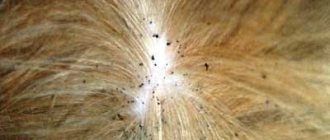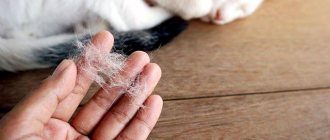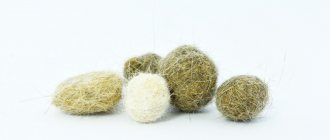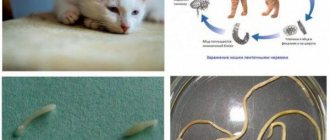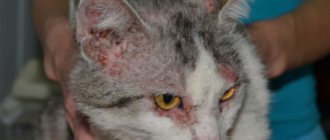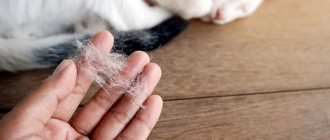Licking and scratching are part of a cat's normal hygiene rituals, but sometimes it seems as if the cat has begun to lick and scratch itself more. Most often it is not scary, but sometimes scabies is a symptom of a number of rather unpleasant diseases.
You should sound the alarm if scratching comes with:
- change in behavior;
- plaintive meowing while scratching;
- loss of appetite or, on the contrary, its increase;
- poor sleep, frequent awakenings to scratch;
- apathy and depression or, on the contrary, aggression and hyperactivity;
- giving up usual and favorite games;
- trying to bite yourself.
Itching itself is not a disease, but only a symptom of many, many ailments. We will tell you about the most popular of them so that you understand what you are faced with.
Causes of itching
So why does a cat itch? The following describes all the possible causes that provoke “pruritus.”
Violation of the protective properties of the skin:
Skin and subcutaneous mites
These include parasitic pathologies such as sarcoptic mange, notoedrosis, cheyletiellosis, otodectosis and (very rarely) demodicosis.
- What becomes noticeable: the cat itches until it bleeds, hair falls out all over the body, crusts appear on the skin, peeling, and dandruff in various places, depending on the problem.
- Otodectosis. The cat's ears generally itch, the head, muzzle, and back of the head itch. Black, smear-like deposits appear in the ears.
- Sarcoptic mange. The neck itches until crusts and wounds appear, the itching is unbearable. Over time, itching develops along the spine, hair falls out in the area of the tail root, and crusts of dried ichor also appear (the owners call such scratches scabs). Another name for the disease is pruritic scabies.
- Notoedrosis. Itching is mainly localized in the head area - muzzle, brow ridges, and back of the head. The cat itches until it bleeds. The skin on the head thickens, becomes rough, and pronounced folding appears (a symptom called “lion’s head”).
- Cheyletiellosis. This disease is caused by small skin mites. The two main signs are that the cat itches all the time, and a lot of scratching and “live” gray dandruff appear in the area of the back and the root of the tail (the parasites themselves are often mistaken for dandruff, and if you look closely, you can see their movements). This disease is popularly called wandering scabies, because symptoms may “move” throughout the body.
Cutaneous blood-sucking parasites
This category of parasitic diseases includes lice, fleas (aphanipterosis) and lice-eaters. In 90% of cases, itching in cats is caused by fleas or their saliva.
- What becomes noticeable: the cat itches a lot (often suddenly attacks itself directly, biting into the skin) and constantly licks itself. In areas of constant licking, bald patches form due to hair loss and breaking off. The insects themselves, their white-transparent eggs, and flea “nests” (clusters of black dots in one place that blur red on wet paper) are discovered. There may be a red rash from the bites.
Allergy
An individual inflammatory reaction in cats can occur to anything: food, medications, care and hygiene products, saliva of blood-sucking insects (flea dermatitis - when there are no fleas, but there is a reaction with itching), dust.
- What becomes noticeable: an undesirable reaction to food is manifested by itching in the head, abdomen and groin area. Contact allergic reactions appear in places where the allergen comes into direct contact with the body (for example, on the stomach and paws after sleeping on a bedding that is poorly rinsed after washing with powder). Flea dermatitis is marked by itching and self-induced alopecia in the back, closer to the root of the tail and the outer surface of the thighs. In a dusty room, cats rub their eyes, eyebrows and nose, sneezing and severe salivation appear.
Bacterial, fungal infections
In most cases, bacteria and fungi join the primary pathology.
- What becomes noticeable: if bacteria have joined, itchy, weeping ulcers and eczema are formed, which the cat endlessly licks, right up to open wounds. With the development of dermatophytosis, itching is accompanied by foci of baldness, peeling, and a limited compacted border around the site of the lesion (often observed with ringworm), i.e. The cat is going bald and itchy. The affected areas can be either individual foci or in the form of a generalized lesion, when a large surface of the body is affected.
Dermatitis
Inflammation of the skin that accompanies almost any injury. This includes parasitic lesions, allergic, neurological, etc. It is more considered a symptom or terminological statement of itching than an independent pathology.
- What owners see: itching is always accompanied by signs of a local inflammatory reaction: redness, swelling, swelling, and sometimes peeling. In special cases where the cat scratches frequently, the temperature of the itchy area may increase.
Increased dry skin
Xerosis or dry seborrhea
With a lack of vitamins A and E in the diet, as well as with the wrong selection of hygiene products for bathing, the skin dries out, cracks and itches badly.
- How it manifests itself: at the very beginning of the development of the pathology, nothing is visible at all - there is only itching. Mostly, the cat itches its back and sides in the area of the ribs, and may gnaw on its paws and joints. This is explained by increased skin tension in areas where skeletal bones protrude. Over time, dandruff appears, and it becomes noticeable that the skin is dry and cracking. Cracks can be almost invisible to the naked eye, or they can develop into large wounds. The wool does not fall out or falls out slightly, but becomes dull, loses its shine and elasticity.
Autoimmune pathologies
They belong to a special category of allergic reactions, when the body begins to perceive its cells and tissues as foreign.
Discoid lupus erythematosus
What owners see: Less common than in dogs. It can occur in any part of the body in the form of suddenly formed wounds. Conventional antimicrobial and wound healing therapy without glucocorticoids is ineffective.
Pemphigus foliaceus
The main localization of itching is in the muzzle, in particular the back of the nose and upper lips. Redness, swelling, ulcerations from itching, and crusts from ichor occur.
Jacobs ulcer
Found only in cats. The disease is similar to herpes on the lips in humans. Initially, spots form on the upper lips, which increase in size and form extensive ulcers. The condition is always accompanied by severe itching. The ulcers develop into extensive eczema, even to the point where the gums and teeth become exposed. Conventional wound healing therapy has no effect.
Reactions that occur after taking medications
What owners notice: itching occurs anywhere and immediately after taking any medication. It may also itch at the injection sites due to the irritating effect of the medication. An itchy rash called hives may appear. The condition is bad because owners do not always associate itching with taking medications.
Neurogenic causes
Neurodermatitis
Similar to atopic dermatitis, but is hereditary. Diagnosis of exclusion.
What you can see: The domestic cat suffers from severe itching in the ears, head and neck. Often the belly and inner thighs, front legs and shoulder blade area are added, transitioning to the back. In advanced conditions, extensive ulcers form. Often a cat simply chews off its paws.
Tumors
What becomes noticeable: in some places of the body various neoplasms appear, which seem to attract the attention of the animal and may be accompanied by itching. In cats, tumors most often form in the mammary glands.
Pathologies of internal organs and systems
Problems with the anal glands
It’s rare, but it happens that a cat’s glands, which are located near the anus, become clogged. This is usually observed from improper feeding, when the secretion thickens and cannot be released naturally.
What becomes noticeable: the cat’s tail itches closer to its base and constantly licks its anus. From time to time the animal rides on its butt. In most cases, owners think that these are worms, but in fact the anal glands are clogged.
Helminths
What the owners can see: in addition to obvious helminths, there is severe itching in the anus. Also, a cat can ride on its butt, similar to problems in the area of the perianal glands. The diagnosis is made by exclusion - first worms, then pathologies with the glands.
For pathologies of the endocrine system, kidneys and liver
in the blood, indicators of substances that characterize the functioning of a particular organ increase (glucose levels, bile acids, nitrogen, urea, creatinine, etc.). When their levels increase critically, skin receptors are irritated from the inside, causing the cat to itch until it hurts.
What is noticeable to the owners: the cat itches and hair falls out all over its body. If, for example, there are diseases of the genital area, then the cat may lick the perineum. In diabetes mellitus, itching is accompanied by increased dryness of the skin and a significant deterioration in the condition of the coat.
Ear problems
Otitis
How it manifests itself: the itching is localized in the ears and neck, the head itches. In addition to the fact that the cat’s ears itch, various discharges are noted inside the ear canal - from serous to purulent and black, plasticine-like, if otitis media is caused by ear mites. The cat shakes its head almost constantly.
Marginal seborrhea of the ears
A disease that affects only the tips of the ears. It is not dangerous for the life of the cat, but it creates visual discomfort for the owners, because The ears look ugly and sloppy. When bacteria attach, these places can become inflamed and rot.
What can be seen: the edges of the ears itch, the cat constantly scratches them, the tips of the ears acquire a ragged edge, peeling appears and the ichor dries out, the skin in these places can thicken.
Psychogenic factors (fears, stress, fears)
Cats are stress-unresistant animals, so any deviation from their psychological comfort can be accompanied by psychogenic itching.
Behavioral obsessive-compulsive disorder (OBCD or OCRD)
It is registered very, very rarely and is a diagnosis of exclusion. When a cat is stressed or bored, the habit of scratching and gnawing appears. A certain psychological dependence on the process itself arises. Most often, the tail itches - it also gets chewed off over time.
Hormonal disorders
Itching due to hormonal changes is recorded extremely rarely (almost never). But there are recorded cases, so this reason cannot be ignored.
What attracts attention: the cat almost constantly licks the perineum, groin and sides, where the ovaries are approximately located.
Infectious skin diseases
Itching in an animal can be caused by an infection that has penetrated into the thickness of the skin through scratches, small wounds, or flea bites. Local inflammation causes the cat to itch furiously, but bacterial infections can be treated well. Veterinarians advise using sulfur ointment or Juglone powder externally. These drugs cope equally well with dermatomycosis and bacterial infections. Systemic treatment may require antibiotics, but these medications should only be given to your pet as directed by a doctor.
Interesting!
Juglone powder, dissolved in an oil base, was rubbed into the skin for ringworm behind the cat's ear. After a few days, the lesion shrank, and after a week of use it disappeared completely. Juglone is a black walnut extract that is used in America to treat parasitic diseases. The drug has a bactericidal, sedative, antifungal, antiprotozoal and immunomodulatory effect. According to expert reviews, the product copes well with skin problems in animals. We have only recently begun to treat dermatoses with this medicine, and the drug is difficult to find on the market.
Juglone Infectious skin lesions in cats are secondary and are not transmitted to humans. Most often, people are the source of infection for cats.
What the owner should do if the cat is itching
The cat began to itch - what should the owner do? If Murka is constantly itching and licking, then the reason should be established as soon as possible. Otherwise, scratches appear on the skin, and the skin itself no longer protects. The risks of developing fungal infections and bacterial ulcers are increasing due to secondary damage to the skin by various pathogens. Considering the number of all possible causes, it is pointless to find out on your own. The maximum that the owner is conditionally allowed to do is treat the cat for ticks and fleas, if this has not been done for a long time.
Self-prescription of antihistamines is also not acceptable! Firstly, not everything that itches is an allergy, and secondly, the mechanism of action of this group of drugs differs from person to person, so they may simply not work. Often in such cases, owners think that they have given a small dosage and increase it, resulting in the cat being poisoned with medications.
Ringworm and other skin lesions in cats caused by fungi
If an adult animal or kitten itches, but there are no fleas, the itching is often associated with the action of a fungus on the skin.
Trichophytosis, ringworm
Trichophytosis is a fungal disease that can be transmitted to people. This is especially dangerous for children, and it is much easier to cure a pet than a person. The disease manifests itself as hair loss in a local area and increased itching of the affected area. As a result of infection, since the pet is constantly itching, an abscess covered with a hard shell often forms under the skin of the bald spot. In this case, it is necessary to remove the pus, but the procedure must be performed by a veterinarian in a clinic setting.
You should not diagnose the disease yourself, since it is easy for an amateur to confuse ringworm (the popular name for trichophytosis) with other effects that have similar manifestations:
- sunburn, especially typical for representatives of short-haired breeds;
- damage from exposure to chemicals;
- hormonal alopecia.
If the diagnosis is established, special ointments offered by veterinary pharmacies are used.
Dermatomycoses
They arise from the infectious effects of fungi. Pets become infected from other animals, unwashed food, dirty objects, and unfavorable living conditions. The disease is often carried by mice.
Characteristic manifestations are scratches, wounds, scratches, reminiscent of those caused by fleas, covered with crusts, constantly itching, disturbing the cat and forcing it to itch.
Analysis of itching in a veterinary clinic
The cat is itching - what should the veterinarian do? There is a certain dermatological algorithm for diagnosing pathologies accompanied by itching, with the help of which its cause is determined:
- mandatory collection of a detailed history of the period preceding the appearance of itching (cat’s age, breed relationship, how and what is fed, whether any medications were taken, what and when the last antiparasitic treatment was carried out, whether there were surgical interventions, the presence of chronic infections, whether they were bathed with anything) - new, etc.),
- direct analysis of itching (intensity, whether there are periods of exacerbation or whether it always itches the same, in which parts of the body the itching is localized, how long the cat has been licking and itching, etc.),
- exclusion of parasitic infections, both fleas and intradermal mites (prescription of effective drugs),
- microscopy of scrapings from scratch sites (exclusion of fungal and bacterial infections),
- examination of the ears and ear canal for otitis or marginal seborrhea,
- detailed survey regarding adverse reactions to food (AFR) - food analysis, food diary, elimination diet,
- collecting information about antipruritic therapy that was used before contacting the veterinarian (what was given, in what dosages, for what duration, what was the result),
- exclusion of atopic allergies,
- assumption of obsessive-compulsive disorders.
If the cause has been identified, then it is it that is eliminated first, and then only antipruritic correction is carried out. Masking “scratchiness”, for example, in case of parasitic diseases without basic treatment, is even contraindicated, because may cause their progression.
What can cats take for itching?
Giving anything against itching without a specialist’s prescription is prohibited! Itching is a symptomatic manifestation of the problem, not the problem itself. If it is eliminated without eliminating the provoking pathology, the disease will progress and worsen the general condition of the cat.
Treatment for itching is:
- etiotropic (elimination of the immediate cause, treatment of the underlying disease),
- symptomatic (prescription of direct drugs for itching).
What to treat is determined exclusively by a specialist. Below is a list of drugs that can give a noticeable antipruritic effect if used correctly, taking into account the main provoking cause (the information is for informational purposes only and is not a direct guide to action without consulting a veterinarian):
- Antihistamines containing cetirizine, hydroxyzine, diphehydramine or chlorpheniramine (Atarax, Zodak, Cetrin, Diphenhydramine, Clemastine, Chlorphenamine, etc.).
- Atopica (a drug containing cyclosporine).
- Glucocorticosteroids (Dexa-kel, Stop-itching, Dexa-fort, Polcortolon, Kenalog).
- Pentoxifylline.
- Psychotropic drugs (Pregabalin, Gabapentin).
- Omega-3,6 fatty acids.
Some of the listed drugs are human, but are used strictly in veterinary dosages!


